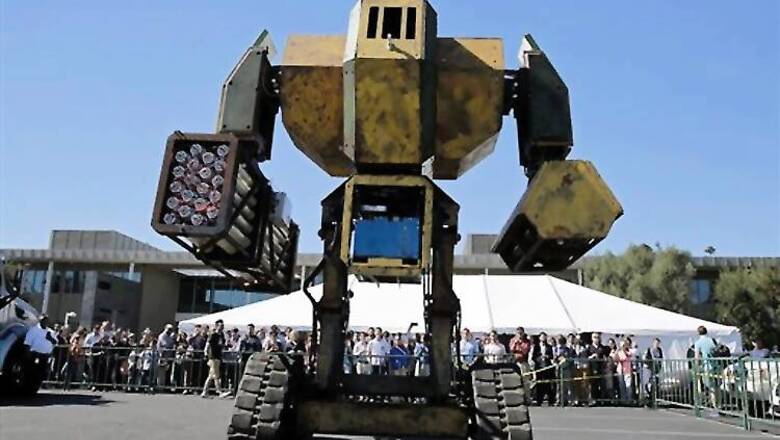
views
Oakland: They've been popularized in movies, television and video games, but giant fighting robots still haven't left the realm of science fiction. That will soon change.
Megabots Inc., an Oakland, California-based startup, has built a 15-foot (4.5-meter) mechanical gladiator called the Mark II and challenged a Japanese firm to an international battle for robot supremacy.
Tokyo-based Suidobashi Heavy Industries, maker of the 13-foot (4-meter) Kuratas, accepted the challenge, setting the stage for the first giant robot battle of its kind next year. The exact date and location are yet to be determined.
Win or lose, it's all part of Megabots' plan by to make gladiator-style robot combat into big-time entertainment — a mix between Ultimate Fighting Championship and Formula One auto racing — while developing new industrial technologies and inspiring a new generation of engineers.
The Megabots founders envision a sports league where teams from around the world build huge humanoid robots that throw each other down in stadiums filled with screaming fans.
"Everyone wins as long as there is robot carnage," said Megabots co-founder Matt Oehrlein, an electrical engineer. "People want to see these things fight. They want to see them punch each other, they want to see them ripped apart and they want to be entertained."
Megabots was launched in 2014 by Oehrlein, Gui Cavalcanti and Brinkley Warren, who grew up playing video games like "MechWarrior" and "BattleTech," and wanted to fulfill their dreams of watching massive machines fight.
"We want to bring the giant robots from science fiction and movies and video games to life because now we have the technology," said Cavalcanti, a robotics engineer. "It's really about: How do we put on the best show? How do we make the coolest fight?"
Inside a cavernous Oakland workshop, the Megabots founders built the Mark II — a 12,000-pound (5,443 kilograms) behemoth with tank treads, two-pilot cockpit and missile launcher that fires canon ball-sized paintballs.
Then Oehrlein called out Suidobashi in a YouTube video: "We have a giant robot. You have a giant robot. You know what needs to happen. We challenge you to a duel."
Suidobashi's founder Kogoro Kurata accepted in his own video: "We can't let another country win this. Giant robots are Japanese culture. Yeah, I'll fight. Absolutely."
Kurata also taunted the Megabots team: "Come on guys, make it cooler. Just building something huge and sticking guns on it, it's super American."
The Megabots robot isn't quite ready to take on Kuratas, a more polished fighting machine with a big, agile hand that mimics the movements of the pilot's hand.
"Our current robot, the Mark II, looks pretty intimidating," Oehrlein said. "The truth is, it's pretty slow. It's top-heavy. It's rusty, and it needs a set of armor upgrades to be able to compete in hand-to-hand combat,"
 In this photo taken Friday, Oct. 9, 2015, MegaBots founders from left, Brinkley Warren, Matt Oehrlein and Gui Cavalcanti stand below their 15-foot tall, piloted Mk.II robot at the Pioneer Summit in Redwood City, Calif. Let the giant robot wars begin. A team of American engineers challenged a group in Japan to a battle for robot supremacy, and the Japanese said bring it on. So Oakland-based MegaBots has launched a Kickstarter campaign to raise money to turn the Mk.II, into a real fighting machine, ready for hand-to-hand combat. (AP Photo/Eric Risberg)
In this photo taken Friday, Oct. 9, 2015, MegaBots founders from left, Brinkley Warren, Matt Oehrlein and Gui Cavalcanti stand below their 15-foot tall, piloted Mk.II robot at the Pioneer Summit in Redwood City, Calif. Let the giant robot wars begin. A team of American engineers challenged a group in Japan to a battle for robot supremacy, and the Japanese said bring it on. So Oakland-based MegaBots has launched a Kickstarter campaign to raise money to turn the Mk.II, into a real fighting machine, ready for hand-to-hand combat. (AP Photo/Eric Risberg)
That's why Megabots launched an online Kickstarter campaign and raised more than $550,000 from robot fans to turn the Mark II into a real fighting machine — faster, tougher, more balanced and equipped with detachable weapons such as a giant chain saw or punching fist.
The startup has enlisted the help of engineers from NASA, software maker Autodesk, the TV shows "Mythbusters" and "BattleBots."
"We're absolutely confident that Team USA can beat Japan. We've assembled the best of the best of this country. We're not going to let our country down," Calvalcanti said.
Robot enthusiasts like Gordon Kirkwood are eagerly anticipating the fight.
"I think it's going to be a smash hit," said Kirkwood, a robotics engineer in San Francisco. "This has the potential to be a fantastic spectator sport that people would really pay good money to see."


















Comments
0 comment